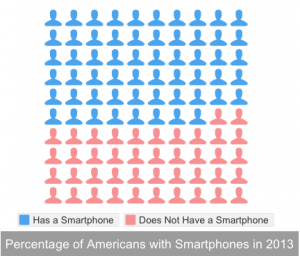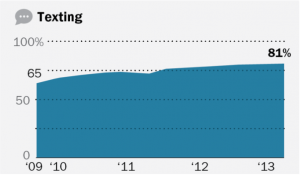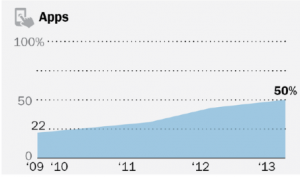In the past several years, there has been increased discussion about bringing medicine into the technological era, and out of the darkness of paper methods and inefficiency. Words and phrases like “media,” “digital,” and “mobile technologies”are becoming more and more linked to healthcare. Because we do live in the age of technology, a time when nearly every person in America owns a cell phone (91%) and uses the internet, such a movement seems not only favorable, but necessary. As we push medicine into the digital age, we applaud new, innovative uses of advanced technology for testing, treating, and tracking—for features that allow the new age of “ePatients” to take control of their health.
One of the most “fashionable” new technologies is the mobile app. Apps allow patients to use their mobile phones to track their diet, exercise, blood pressure, etc. With so many emerging uses, smartphones provide a promising avenue to increased ePatient activity. As a result, when people think of patient-centered health media, the first thing that comes to mind is generally mobile apps—or is it?
When I say “people,” this is a very biased demographic. I am a Rice University student in a Medical Media Arts class. While my peers come from very diverse backgrounds, our current lifestyle places us in a specific demographic—that of educated young people who are exposed to mobile technology, specifically smartphones, on a daily basis. Those developing mobile health technologies generally come from similar backgrounds, in that they are most likely very familiar with smartphone usage, and quite possibly own smartphones themselves. For a significant portion of the population, this is not the case.
According to Pew Research, only 58% of Americans own a smartphone. While this is more than half of the population, this still means that roughly 131.8 million Americans (42%) do not own a smartphone or have access to mobile applications.
One of the many advantages of mobile technology is its ubiquitous nature and its potential to bridge health disparities by reaching large, diverse populations. However, if all of our focus is placed in a sector of mHealth that such a significant portion of people do not have access to, we are only compounding health disparities with a technological one.
While I believe that mobile applications are a very promising avenue of healthcare, I think that other mobile phone capabilities should continue to be utilized. For example, while only 50% of cell phone owners download mobile apps, 81% send and receive text messages. Text messaging is a simple, low-cost technology, which can be utilized with or without a smartphone, and has consistently been in greater use than mobile apps.
While text message-use is beginning to level-out, mobile app usage is still increasing. However, until the transferral to mobile apps is complete, the “non-app” population should not be ignored. Text message-based mHealth campaigns have already been developed, such as Txt4health, SmokefreeTXT, and text4baby. All of these services promote positive health behaviors by sending text message reminders to patients in the program. We should use these programs as models while we consider avenues that promote patient-centered healthcare and patient engagement, and be mindful of who we are trying to reach and how to best reach them. While mobile applications are a promising platform, which should definitely be utilized, we also have to ensure that we make mobile technologies the solution and not the problem in addressing health disparities.



